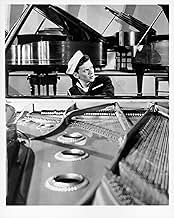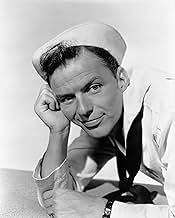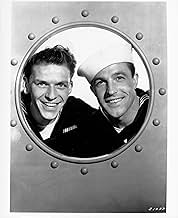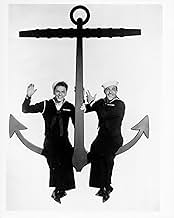IMDb RATING
7.0/10
9.8K
YOUR RATING
A pair of sailors on leave try to help a movie extra become a singing star.A pair of sailors on leave try to help a movie extra become a singing star.A pair of sailors on leave try to help a movie extra become a singing star.
- Directors
- Writers
- Stars
- Won 1 Oscar
- 5 wins & 4 nominations total
Rags Ragland
- Police Sergeant
- (as 'Rags' Ragland)
Carlos Ramírez
- Carlos
- (as Carlos Ramirez)
- Directors
- Writers
- All cast & crew
- Production, box office & more at IMDbPro
Summary
Reviewers say 'Anchors Aweigh' is a classic MGM musical with Gene Kelly, Frank Sinatra, and Kathryn Grayson. It features memorable dance sequences, vibrant Technicolor, and innovative camera work. Themes of love, friendship, and ambition are explored. Songs by Jule Styne and Sammy Cahn enhance the charm. Despite some criticisms of length and pacing, the film is celebrated for its entertainment value and historical significance.
Featured reviews
What surprises me here is how good Sinatra is. He's certainly playing against his later cock-sure image. No king of the walk here. Instead his Clarence (note the name) is likable but chock-full of self-doubt. And he's very good at being shy, retiring, and charming in a boyish way. It's a Sinatra as I've never seen him. On the other hand, there's the boldly self-assured Joe (Kelly) who dominates, as the two sailors try to get a big-time audition for the winsome Susan (Grayson). Somehow, however, they can't reach big-time impresario Jose Iturbi. But they and we have a good time trying.
Along the way, Kelly gets his legendary dance with cartoon mouse Jerry of Tom & Jerry, looking like it came right out of the Land of Oz. Then too, I like his really charming number with the little Mexican girl (McManus). Overall, however, it's the elaborate sets, glossy Technicolor, and sparkling personalities that shine. Frankly, I thought the musical selections were entertaining but nothing memorable. Also the storyline meanders a bit too much, particularly near the end. Note too how classical numbers are worked into the selections, quite typical for that time. I guess producers wanted to broaden the musical appeal, and lend a touch of 'class'.
All in all, the movie's MGM at it's glossy best. And though a bit overlong, the results still fit the classic bill, along with the perfect pairing of the two male leads.
Along the way, Kelly gets his legendary dance with cartoon mouse Jerry of Tom & Jerry, looking like it came right out of the Land of Oz. Then too, I like his really charming number with the little Mexican girl (McManus). Overall, however, it's the elaborate sets, glossy Technicolor, and sparkling personalities that shine. Frankly, I thought the musical selections were entertaining but nothing memorable. Also the storyline meanders a bit too much, particularly near the end. Note too how classical numbers are worked into the selections, quite typical for that time. I guess producers wanted to broaden the musical appeal, and lend a touch of 'class'.
All in all, the movie's MGM at it's glossy best. And though a bit overlong, the results still fit the classic bill, along with the perfect pairing of the two male leads.
In the Citadel film series book The Films of Gene Kelly, Anchors Aweigh is described as a kingpin of a musical. I sure can't do better than that. It's such an important film in both the careers of Gene Kelly and Frank Sinatra. Kathryn Grayson didn't do too badly with this either.
Louis B. Mayer had lent Gene Kelly out to Columbia where Harry Cohn had an inspiration to let Kelly choreograph his own numbers and because of it, Cover Girl became a classic. So if Mayer didn't learn a lesson, producer Joe Pasternak did and allowed Kelly artistic control. When Anchors Aweigh was finished, Fred Astaire at last had a dancing rival for monarch of cinema dance.
The main number everyone talks about with Gene Kelly here is the dance with Jerry Mouse. Originally Kelly wanted to do the number with Walt Disney's Mickey Mouse, but Disney wasn't lending Mickey out to nobody. Mickey would have to wait until Who Framed Roger Rabbit to do an outside film. Not to worry because MGM had it's own animated rodent one half the team of Tom and Jerry.
Kelly as dancer always strived to do something new and different on screen as did Fred Astaire. For the next dozen years, these two were allowed all kinds of artistic control and were praised for their work even if the films themselves weren't up to snuff. It was like each inspired the other to bigger and better creativity, Kelly for MGM, Astaire for MGM and any number of other studios. In Anchors Aweigh, Kelly got Sinatra to dance a bit. In fact Frank Sinatra always gave credit to Gene Kelly for showing him how musicals should be done as he gave credit to both Burt Lancaster and Montgomery Clift for their help in earning him is Oscar for From Here to Eternity.
When Frank Sinatra had half of his contract bought from RKO by MGM he insisted on a little artistic creativity on his own. He'd become friends with the songwriting team of Jule Styne and Sammy Cahn. In his autobiography Sammy Cahn tells about how Sinatra insisted that they write his songs for this film. Louis B. Mayer gave in and the team wrote some really fine ballads for him to sing. One of my favorite Sinatra numbers comes from Anchors Aweigh, I Fall in Love Too Easily. Frank sings it accompanying himself on the piano at an empty Hollywood Bowl. It's Sinatra at his best.
With Jule Styne and later with Jimmy Van Heusen, Sammy Cahn richly earned the title of having put more song lyrics in Frank Sinatra's mouth than any other person. They were lifetime friends and Cahn always credited Sinatra with this milestone boost in his career.
On a bet Styne and Cahn said they could write a song just using a chromatic scale. They proved it in Anchors Aweigh when Kathryn Grayson put her soprano to work on All of a Sudden My Heart Sings. She also did some classical numbers.
Here singing in fact is the basis of the plot. Two sailors on leave through a combination of circumstances meet up with Kathryn Grayson and her orphaned nephew Dean Stockwell. Trying to fix her up with Sinatra, Kelly says he can get her an audition with Jose Iturbi. They spend the film trying to accomplish just that.
My only disappointment in Anchors Aweigh was that Pamela Britton, who plays the waitress 'Brooklyn' never got a number herself. She had gotten rave reviews from her performance as Meg Brockie in Brigadoon on Broadway and that's what brought her to Hollywood. I have a suspicion she had a number that was cut and somewhere in MGM's vaults it might still be.
Anchors Aweigh is a great example of why musicals just aren't made any more. All that creative talent was under contract to Metro-Goldwyn- Mayer. If you had to pay market value for it, the cost might retire some third world country's debt.
But the film results would be extraordinary.
Louis B. Mayer had lent Gene Kelly out to Columbia where Harry Cohn had an inspiration to let Kelly choreograph his own numbers and because of it, Cover Girl became a classic. So if Mayer didn't learn a lesson, producer Joe Pasternak did and allowed Kelly artistic control. When Anchors Aweigh was finished, Fred Astaire at last had a dancing rival for monarch of cinema dance.
The main number everyone talks about with Gene Kelly here is the dance with Jerry Mouse. Originally Kelly wanted to do the number with Walt Disney's Mickey Mouse, but Disney wasn't lending Mickey out to nobody. Mickey would have to wait until Who Framed Roger Rabbit to do an outside film. Not to worry because MGM had it's own animated rodent one half the team of Tom and Jerry.
Kelly as dancer always strived to do something new and different on screen as did Fred Astaire. For the next dozen years, these two were allowed all kinds of artistic control and were praised for their work even if the films themselves weren't up to snuff. It was like each inspired the other to bigger and better creativity, Kelly for MGM, Astaire for MGM and any number of other studios. In Anchors Aweigh, Kelly got Sinatra to dance a bit. In fact Frank Sinatra always gave credit to Gene Kelly for showing him how musicals should be done as he gave credit to both Burt Lancaster and Montgomery Clift for their help in earning him is Oscar for From Here to Eternity.
When Frank Sinatra had half of his contract bought from RKO by MGM he insisted on a little artistic creativity on his own. He'd become friends with the songwriting team of Jule Styne and Sammy Cahn. In his autobiography Sammy Cahn tells about how Sinatra insisted that they write his songs for this film. Louis B. Mayer gave in and the team wrote some really fine ballads for him to sing. One of my favorite Sinatra numbers comes from Anchors Aweigh, I Fall in Love Too Easily. Frank sings it accompanying himself on the piano at an empty Hollywood Bowl. It's Sinatra at his best.
With Jule Styne and later with Jimmy Van Heusen, Sammy Cahn richly earned the title of having put more song lyrics in Frank Sinatra's mouth than any other person. They were lifetime friends and Cahn always credited Sinatra with this milestone boost in his career.
On a bet Styne and Cahn said they could write a song just using a chromatic scale. They proved it in Anchors Aweigh when Kathryn Grayson put her soprano to work on All of a Sudden My Heart Sings. She also did some classical numbers.
Here singing in fact is the basis of the plot. Two sailors on leave through a combination of circumstances meet up with Kathryn Grayson and her orphaned nephew Dean Stockwell. Trying to fix her up with Sinatra, Kelly says he can get her an audition with Jose Iturbi. They spend the film trying to accomplish just that.
My only disappointment in Anchors Aweigh was that Pamela Britton, who plays the waitress 'Brooklyn' never got a number herself. She had gotten rave reviews from her performance as Meg Brockie in Brigadoon on Broadway and that's what brought her to Hollywood. I have a suspicion she had a number that was cut and somewhere in MGM's vaults it might still be.
Anchors Aweigh is a great example of why musicals just aren't made any more. All that creative talent was under contract to Metro-Goldwyn- Mayer. If you had to pay market value for it, the cost might retire some third world country's debt.
But the film results would be extraordinary.
Released some months before the end of the war, "Anchors Aweigh" is one of Gene Kelly's major musical triumphs of the forties
Under the direction of George Sidney, it had the benefits of a pleasant score, andbest of allthe services of Gene Kelly in his first true starring role at MGM The year before, in Columbia's "Cover Girl," he had revealed an innovative approach to dance on the screen, a light but agreeable singing voice, and considerable charm In "Anchors Aweigh," although he was billed under Frank Sinatra and Kathryn Grayson, he was laying the solid groundwork for his most revealing years at MGM
The film's story, a kind of dry run for "On the Town" four years later, follows sailors Kelly and Sinatra on shore leave, spend their holiday in Hollywood, where they become involved in the affairs of an aspiring singer (Grayson) and her little nephew (Dean Stockwell).
Grayson, it appears, has her heart set on an audition with conductor-pianist Jose Iturbi She gets the audition, of course; Kelly gets Grayson after some misunderstandings; and Sinatra, has forgotten to be shy, and has lost his heart to a girl from Brooklyn (Pamela Britton).
The plot is conventional for the period but, regrettably, it now seems barely tolerable But there is Gene Kelly, who dominates the movie with his agreeable personality Perhaps he grins too much, but when is permitted to dance, the film finally lifts off the ground
"I Begged Her," his early song and dance with Sinatra, is amusing and slightly absurd, in which he imagines himself as a bandit chieftain in a Spanish courtyard, courting maiden Grayson with a flamboyant flamenco dance and some athletic leaps He also does a charming Mexican dance with little Sharon McManus in the square of a Mexican settlement in Los Angeles
The highlight of the movie, however, is Kelly's famous dance with the cartoon character Jerry the Mouse (of "Tom and Jerry" fame). Delightful and innovative, it skillfully combines live action and animation in its tale of a sad mouse king who refuses to allow music in his kingdom until Kelly, a sailor in the "Pomeranian Navy," wearing a striped shirt and a beret, shows him how to dance "Look at me, I'm dancin'!" says the gleeful mouse king...
Under the direction of George Sidney, it had the benefits of a pleasant score, andbest of allthe services of Gene Kelly in his first true starring role at MGM The year before, in Columbia's "Cover Girl," he had revealed an innovative approach to dance on the screen, a light but agreeable singing voice, and considerable charm In "Anchors Aweigh," although he was billed under Frank Sinatra and Kathryn Grayson, he was laying the solid groundwork for his most revealing years at MGM
The film's story, a kind of dry run for "On the Town" four years later, follows sailors Kelly and Sinatra on shore leave, spend their holiday in Hollywood, where they become involved in the affairs of an aspiring singer (Grayson) and her little nephew (Dean Stockwell).
Grayson, it appears, has her heart set on an audition with conductor-pianist Jose Iturbi She gets the audition, of course; Kelly gets Grayson after some misunderstandings; and Sinatra, has forgotten to be shy, and has lost his heart to a girl from Brooklyn (Pamela Britton).
The plot is conventional for the period but, regrettably, it now seems barely tolerable But there is Gene Kelly, who dominates the movie with his agreeable personality Perhaps he grins too much, but when is permitted to dance, the film finally lifts off the ground
"I Begged Her," his early song and dance with Sinatra, is amusing and slightly absurd, in which he imagines himself as a bandit chieftain in a Spanish courtyard, courting maiden Grayson with a flamboyant flamenco dance and some athletic leaps He also does a charming Mexican dance with little Sharon McManus in the square of a Mexican settlement in Los Angeles
The highlight of the movie, however, is Kelly's famous dance with the cartoon character Jerry the Mouse (of "Tom and Jerry" fame). Delightful and innovative, it skillfully combines live action and animation in its tale of a sad mouse king who refuses to allow music in his kingdom until Kelly, a sailor in the "Pomeranian Navy," wearing a striped shirt and a beret, shows him how to dance "Look at me, I'm dancin'!" says the gleeful mouse king...
Famous for the scene where Gene Kelly dances a duet with Jerry Mouse, this zippy musical is also the one where Kathryn Grayson trills 'Jealousy', and Frank Sinatra sings in the arena of a thousand pianos ('I Fall in Love Too Easily'). Grayson is a young mother who wants more than anything else to be in the movies. Her little boy (Dean Stockwell, who would turn up much later in TV's Quantum Leap) wants to join the US forces, and so he meets sailors Kelly and Sinatra heading out for a bit of leave. There are some echoes of 'On the Town' in this movie, but not enough to spoil the mix.
Anchors Aweigh is not a favourite of mine by all means, but I do enjoy it. It is overlong, the story is somewhat slight and the dialogue is unexceptional. Despite its failings, it is enjoyable. The production values are pleasing to the eye, while the score and songs are very pleasant and the choreography sprightly. The direction is good enough, while the pace while slightly mannered I had little problem with, as there are certain delights that stop the film from being dull. The cast, dancing and singing are excellent. Gene Kelly is always likable and here is no exception, while Frank Sinatra delights with his beautiful voice and and Kathryn Grayson is graceful and beautiful. The real delight though is the film's most famous sequence and no surprise really, the sequence when Kelly dances with Jerry of Tom and Jerry fame is as clever as it is memorable. So overall, not exceptional by all means, but there is much to enjoy still. 7/10 Bethany Cox
Did you know
- TriviaWhen the dance sequence with Gene Kelly and Jerry Mouse was screened for MGM executives, someone noticed that, although Gene Kelly's reflection shone on the floor during his dancing, Jerry's did not. This required animators William Hanna, Joseph Barbera, and their team to go back and draw Jerry's reflection on the floor as he was dancing.
- GoofsWhen Clarence is singing to the waitress in the restaurant, there is a picture of Susita on the wall. When seen at a distance, her head is tilted to the left, but in a closeup, her head is vertical.
- Quotes
Jerry Mouse: Look at me, I'm dancing.
- Crazy credits[in some versions, after the end credits]
TO FAMILIES AND FRIENDS OF SERVICEMEN AND WOMEN:
Pictures exhibited in this theatre are given to the armed forces for showing in combat areas around the world.
WAR ACTIVITIES COMMITTEE MOTION PICTURE INDUSTRY
- ConnectionsEdited into American Masters: Gene Kelly: Anatomy of a Dancer (2002)
- SoundtracksAnchors Aweigh
(1906) (uncredited)
Music by Charles A. Zimmerman
Played off-screen during the opening credits
Played by a Navy Band conducted by José Iturbi
- How long is Anchors Aweigh?Powered by Alexa
Details
Box office
- Gross worldwide
- $2,556
- Runtime2 hours 20 minutes
- Aspect ratio
- 1.37 : 1
Contribute to this page
Suggest an edit or add missing content









































